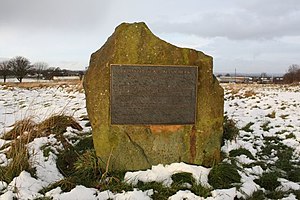Battle of Adwalton Moor
| Battle of Adwalton Moor | |||||||
|---|---|---|---|---|---|---|---|
| Part of the First English Civil War | |||||||
 Battle Plaque at Adwalton Moor |
|||||||
|
|||||||
| Belligerents | |||||||
| Royalists | Parliamentarians | ||||||
| Commanders and leaders | |||||||
| Earl of Newcastle |
Sir Thomas Fairfax Major General Gifford |
||||||
| Strength | |||||||
| 10,000 | 3,500 | ||||||
The Battle of Adwalton Moor was a battle in the English Civil War on 30 June 1643.
The site of the battle is high ground in Adwalton (now commonly considered to be part of Drighlington) near Bradford, which is now in an area of rural-urban fringe, (map reference SE2228). Parts of the site are protected as "green belt" or other types of open space. It is the only battlefield recognised by Bradford Metropolitan District Council as falling within its boundaries but it actually lies within the Leeds City Council boundary. There are plaques interpreting the battlefield for visitors.
The Earl of Newcastle, the Royalist commander, was marching on Bradford (which was Parliamentarian in sympathy) with 10,000 men. Fairfax, the Parliamentary commander, had 3,000-4,000 men in Bradford. However, despite his inferior numbers, Fairfax came to intercept the Royalist army as Bradford was ill-prepared to resist a siege. The strong Royalists defeated the Parliamentarians. The battle was of medium term significance, consolidating Royalist control of Yorkshire.
There is a display relating to the battle at Bolling Hall, Bradford, a museum which lies a few miles from the site and was itself a Royalist base. Oakwell Hall is another museum which throws light on the civil war in Yorkshire: although the hall is situated within walking distance from the battlefield, it falls outside the boundaries of Bradford and within those of Kirklees.
...
Wikipedia
